November 19, 2021
Air Date: November 19, 2021
FULL SHOW
SEGMENTS

A Generational Investment
View the page for this story
The bipartisan infrastructure bill sets aside $1.2 trillion dollars in funding for clean water, bridges, and roads, as well as higher-tech infrastructure like EV charging stations and electric school buses. Joseph Kane, a labor economist at the Brookings Institution, joins Host Steve Curwood to talk about how the implementation of these projects needs to focus on creating equitable and sustainable systems that will last for generations. (10:26)

Beyond the Headlines
/ Peter DykstraView the page for this story
This week, Environmental Health News Editor Peter Dykstra joins Host Bobby Bascomb to talk about a potential “carbon bomb” in the form of a court-ordered oil and gas lease sale in the Gulf of Mexico, and an island in the Chesapeake Bay being doomed by rising sea levels. And in history: an anniversary of Alfred Nobel’s patent for dynamite. (04:03)
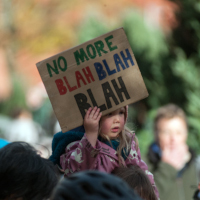
Little Progress at COP26
View the page for this story
The COP26 climate talks in Glasgow, Scotland brought mixed results with an agreement to phase down coal, side agreements to cut methane emissions and a rulebook for international carbon trading markets. But there was little progress in efforts to help developing countries cope with the effects of climate change and the talks were widely criticized for their lack of inclusivity. Most importantly, COP26 failed to establish a fully credible path to limit global warming to 1.5 degrees Celsius. Alden Meyer, a Senior Associate at the think tank E3G, joined Host Steve Curwood to discuss the outcomes of COP26 and look ahead at what's left to be done. (11:44)
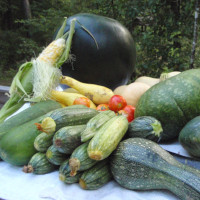
Three Sisters Stew for a Plant-Based Feast
View the page for this story
The Three Sisters are a trio of staple crops that have played a fundamental role in numerous Native American tribes throughout history. The corn, beans, and squash all grow together in a symbiotic planting relationship. Chef Steven Looney talks with Host Steve Curwood about the history and significance of these crops and suggests some recipes from his Chickasaw heritage. (05:45)
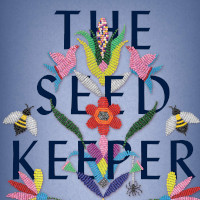
The Seed Keeper
View the page for this story
For many Native American communities, seeds are living and life-giving organisms which should be carefully kept and cherished. But because of industrial agriculture and monocropping, more than 90% of our seed varieties have disappeared in the last century. The Seed Keeper is a novel that relays the importance of seed keeping across 4 generations of Dakota women who have experienced austerity and discrimination through war and American Indian residential schools. Diane Wilson is an award-winning author and the Executive Director for the Native American Food Sovereignty Alliance and she joined Host Bobby Bascomb to discuss The Seed Keeper. (15:15)
Show Credits and Funders
Show Transcript
11119 Transcript
HOSTS: Bobby Bascomb, Steve Curwood
GUESTS: Joe Kane, Steven Looney, Alden Meyer, Diane Wilson
REPORTERS: Peter Dykstra
[THEME]
CURWOOD: From PRX – this is Living On Earth.
[THEME]
CURWOOD: I’m Steve Curwood.
BASCOMB: And I’m Bobby Bascomb
A look ahead after mixed results at the COP 26 climate talks
MEYER: Next year will be the real test, can we get additional momentum going here. Of course an open question is, the countries that committed to reducing deforestation or phasing down methane emissions or phasing out coal, will they reflect those commitments in their formal nationally determined contributions under Paris.
CURWOOD: Also, caring for the seeds that care for us.
WILSON: In the fall this time of year what's the best thing to do but to get together with your family and your community and share your harvest. So when you're doing seed work you're building community, you're protecting the seeds and you're also taking care of not only your own health but also the health of the soil.
CURWOOD: That and more this week on Living on Earth – Stick Around!
[NEWSBREAK MUSIC: Boards Of Canada “Zoetrope” from “In A Beautiful Place Out In The Country” (Warp Records 2000)]
[THEME]
A Generational Investment
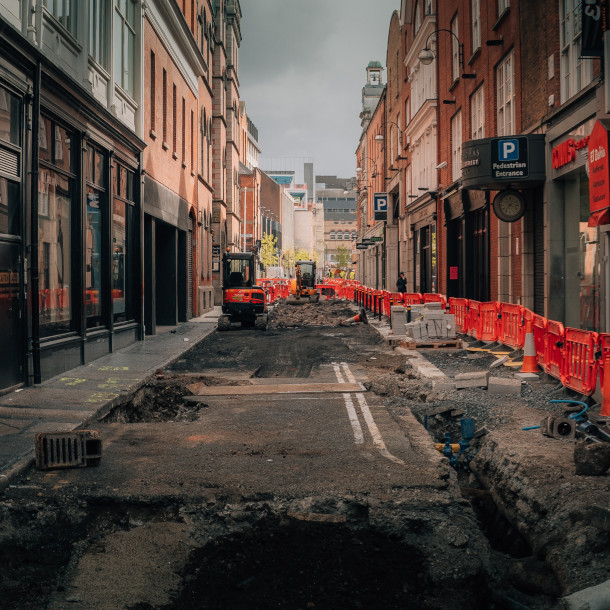
“Shovel ready” projects like paving roads and fixing potholes are some of the first that will be addressed by local governments with the infrastructure funds since many already have implementation plans in place.But new rules could require localities to also consider equity concerns.(Photo: Majestic Lukas on Unsplash)
BASCOMB: From PRX and the Jennifer and Ted Stanley studios at the University of Massachusetts Boston. This is Living on Earth, I’m Bobby Bascomb.
CURWOOD: And I’m Steve Curwood.
When President Biden recently signed into Law the “Infrastructure Investment and Jobs Act” it set into motion activities that could last for years or even decades. Now instead of Congress signing off on a piecemeal basis to repair broken bridges, clean up water supplies and build with climate smart tech and resilience, there is a federal pot of $1.2 trillion set aside for the next five years to address infrastructure on a strategic and sustainable basis. And at the start, a challenge for the feds, states and localities is figuring out how to share these vast resources equitably. Joe Kane is a labor economist who thinks about infrastructure as a Fellow at The Brookings Institution in Washington, DC, and he’s on the line now. Hi Joe, welcome to Living on Earth.
KANE: Thanks for having me.
CURWOOD: So tell me, how well prepared are states and local leaders to move forward with infrastructure plans, now that, what, half a trillion dollars in new money plus reauthorization of old money is moving ahead out of the federal government?
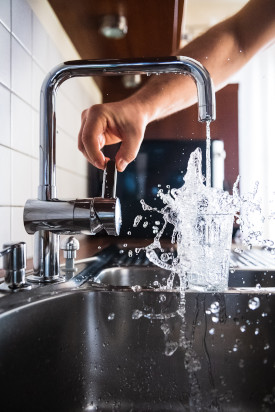
Many water utilities around the nation are still serviced by lead pipes potentially contaminating drinking water. With more funding from the infrastructure bill these pipes can be replaced. (Photo: Jacek Dylag on Unsplash)
KANE: Yeah, we're now past the, what I like to call, the political phase of the infrastructure bill on Capitol Hill, and now we're quickly transitioning to an implementation phase at a federal state and local level in terms of actually getting all this new funding out there, to different projects and and to different communities. States and localities are our primary infrastructure owners and operators, when you think of transportation departments, water utilities, planning departments, they all have tremendous oversight of these issues. And at the end of the day, they're going to ultimately determine the full reach and impact of a lot of this funding. But, you know, not all places are going to be evenly ready to hit the ground running in terms of having all the plans on the books, having all the data, having even the staff in place to implement all this. So I think it'll be interesting to see you in the next few months and years to come.
CURWOOD: So you're a labor economist. And there are a couple of layers of workers involved here. First of all the knowledge workers who know about what could happen, and we're talking about innovation here, I think we kind of figured out how to make roads, you know, paving them and such, but say designing an electric vehicle charging station system for a locality, or something that's relatively innovative, people are going to have to know about them and know how to apply for them. And then on the other side, you have the workforce that's actually going to build this stuff out. So where do we stand on both of those counts what do state and local governments have in terms of people who will be all set to work up applications for these innovations? And how are we set for people who will actually be able to implement them?
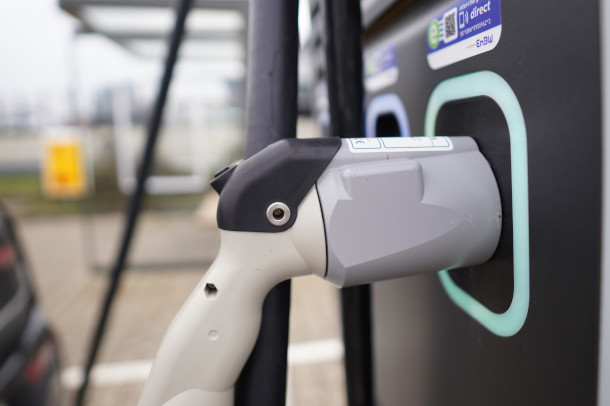
EV charging stations are one of the newer technologies that received $7.5 billion in the infrastructure bill. (Photo: Sophie Jonas on Unsplash)
KANE: Now, that's a great point. And for a very long time in the infrastructure space, workers have been overlooked in a lot of these conversations, I think. Especially among political leaders who often control the purse strings here and not not just in Washington, but at a state and local level, mayors, governors and others. It's a lot easier to focus on the ribbon cutting at the bridge, or the shiny new object and not so much, who is exactly going to be responsible for constructing this facility. And more importantly, who is going to be responsible for operating and maintaining it for decades to come? Because that's the point of infrastructure, I think, ideally, is it supposed to be long lived, the reality is, unfortunately, the talent pipeline to fill many of these positions is empty. It's not just about job growth, you know, and having new solar installers and wind turbine technicians who, who definitely matter in terms of new types of jobs emerging here, but it's about replacing some of the skilled talent that's already in this space. And many of these workers are aging, similar to the infrastructure they're taking care of. They're at the end of their careers. And, and so we have to fill this pipeline, and that does start often at a state and local level. And some of those same agencies that are taking on these projects, where are they going to hire and train the future infrastructure workforce, and often they haven't done that. And so this as much as this can serve as an opportunity, and a springboard to connect to more and different types of workers in this space is a crucial opportunity not to be overlooked.
CURWOOD: Well, so where are the resources for state and local government to get people trained? What's there to support education? I'm thinking of everything from community college, vocational, places where maybe it's many years in school, maybe it's a few months of education. What resources does this funding offer so that a state or a locality could start to get these people trained? Or they have to reach in their own pockets for this?
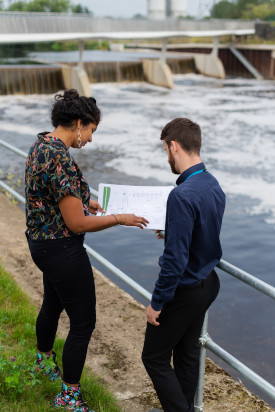
The workforce is often overlooked in the planning of infrastructure. Administrators, planners, and grant writers should be considered as much as construction workers. (Photo: This is Engineering on Unspalsh)
KANE: Yeah, again, another another good question that we don't quite know the answer to yet. I will say initial proposals put forward by the Biden administration had much more dedicated funding, for apprenticeships, for Earn and Learn opportunities for many of these positions that are in the skilled trades that emphasize on the job training, not necessarily advanced levels of formal education. And that was stripped out from this bill. A lot of it now appears in the second reconciliation package, that's still up for debate. And so that still is to be determined to the extent that that funding comes through. But at the end of the day, states and localities often have to coordinate with employers directly. So not even just public agencies, but private employers, construction firms, consulting companies, design firms, they all have to have skin in this game to because they have to provide the opportunities for workers to actually get the immersion and exposure to the types of work in this space. It's not a simple matter of just hiring someone on the job and it's over, you know, we have to have continued training, you have to have certifications, you have to demonstrate competencies over time. And ideally, we're not just training, you know, entry level workers to kind of fall off a cliff but, but ultimately can become the managers and leaders of tomorrow.
CURWOOD: Let's talk about equity. I mean, what can states and localities do to ensure equity when making these plans and ensure that underrepresented community needs are met? It's a no brainer that the infrastructure is often the worst in poor and minority communities. I mean, lead pipes are famous there, the bridges, the roads are tough. Hello, is there an internet in this part of town? How can the equity question be addressed with all this money coming at these things?
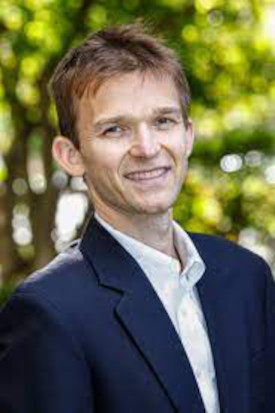
Joseph Kane of Brookings Institution. (Photo: Courtesy of Joseph Kane)
KANE: Absolutely, I mean, economic equity should be foundational to how we plan design, operate our infrastructure, not just simply construct it, but actually operate it over time. And for a very long time, you know, going back, I'd say that broken 20th century framework, which we tend to rely on across the country, you know, we often don't design around people and place. We often design around cars, we design around physical things. And that creates a destructive legacy in many places where we literally have created highways that have carved through whole communities and disconnected them from opportunity. And so a fundamental rethinking, I think of some of these legacy costs, and hopefully benefits that could come out of, of this rethinking involves certainly new types of plans and community engagement, actually involving those who have been marginalized and excluded in these conversations matters. Having new types of data and performance measures. If we are not actually integrating new types of data into how we're measuring where we should target these investments, if we're just simply relying on Hey, that roads congested, let's just throw more money at it and widen it. I mean, we're kind of missing the point, right? Because we need to actually identify who's using that road. Is it serving all types of users? Is it dividing a community? And that's just for transportation? I mean, for water infrastructure? What is, you brought up the lead pipe issue, certainly in communities like Flint, but many others across the country. Where are those pipes even located? I mean, we have more than 50,000 water utilities across the country. And it's very difficult to pinpoint exactly where some of those legacy issues even are. And so as much as we just throw money at the problem, that's not necessarily going to solve all of this as much as if we have better plans and better data and better performance measures to target those investments. Because, you know, half a trillion dollars is a lot of money, but it's not infinite, right? And if we really want to stretch the dollar, to help more people in places, we have to better measure where those monies are going.
CURWOOD: Joe, what you're describing, that needs to happen is going to take longer than any particular presidential term, maybe even longer than a couple of presidential terms. And right now, our political environment is well, I guess maybe one could use the word volatile. How does this get implemented on a sustainable basis? Above the rather bitter, almost sometimes no prisoners taken political process we have?
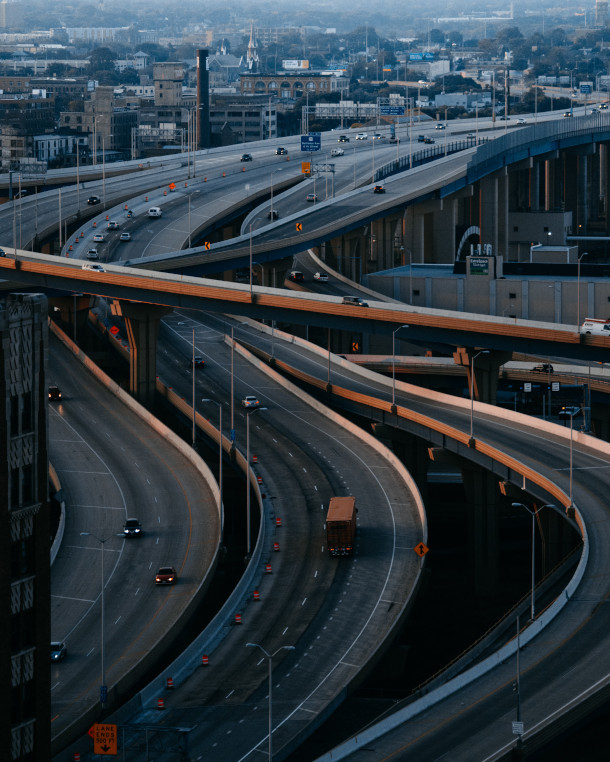
Highways have historically been built through minority neighborhoods, decimating communities. Equity needs to be at the forefront of new infrastructure plans. (Photo: Tom Barrett on Unsplash)
KANE: Yeah, look, I mean, we're fortunate in that infrastructure is traditionally a bipartisan issue. You know, elections can be disruptive in the sense of where's the funding certainty for some of these projects? And I think that's been the challenge for a lot of state and local governments who have had to weather this storm. But I think the hope has to be that in the creation of these new programs, and the creation, and execution and implementation of these programs, are they creating sustainable benchmarks, right, by which federal agencies can keep this going over time, regardless of who's sitting in the White House? I think that has got to be the hope here is that when we do all this legwork on implementation, which is why I emphasize this phase we're in right now is so crucial, that everyone kind of was focused on Capitol Hill, and kind of the politics and the horse trading of all this, which which mattered in terms of the final dollar sign. But we have to move past dollar signs and alarm bells. And we have to understand that this challenge is very nuanced, it's generational, it's going to require a lot of rolling up of sleeves at the federal level in coordination with state local governments to create those programs. So it's an understanding of, hey, this is how we do things, right. Climate is centered and how we design and measure the needs of projects. We're going to center this around workforce development and making sure we have a sustained pipeline of talent, that we can actually fill the roles that we need to fill. These are the sorts of questions leaders need to keep asking themselves as a result of this moment. And it shouldn't just be over the next five years. It should be a conversation we're having ongoing right regardless of who's in office.
CURWOOD: Joe Kane is an economist and Fellow with the Metropolitan Program at The Brookings Institution. Joe, thanks for taking the time with us today.
KANE: Thanks again for having me.
Related links:
- Read more about Joseph Kane’s work
- Watch the video of President Biden signing the infrastructure bill into law
- Read more about the infrastructure bill on the White House website
[MUSIC: Cyrus Chestnut, “Whoopi” on Earth Stories, Atlantic Records]
Beyond the Headlines
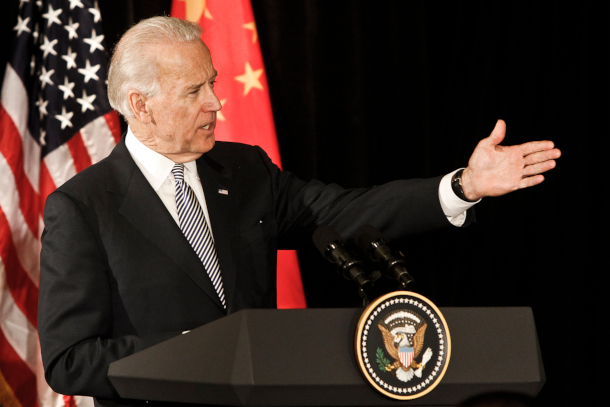
President Biden to hold court-mandated oil and gas sale. (Photo: Antonio R. Villaraigosa, Flickr CC BY-NC 2.0)
BASCOMB: Well, it's time for a trip now beyond the headlines with Peter Dykstra. Peter's an editor with Environmental Health News. That's ehn.org and dailyclimate.org. Hey there Peter, what do you have for us this week?
DYKSTRA: Well, hi, Bobby. We're only days out from the Glasgow Climate Summit. Some people are happy with the results, some people very angry about what they see as the lack of results. And only a few days out there is going to be a US federal government carbon bomb in the form of an oil and gas lease sale in the Gulf of Mexico.
BASCOMB: Hmm. Well, I know that President Biden campaigned on, you know, a moratorium on drilling in federal land and waters. So this kind of flies in the face of that, but from what I understand, he really had no choice.
DYKSTRA: Yeah, environmentalists are still angry that such a firm promise was made, and that it depending on what happens in court won't be kept. This was a lease sale that was created by the Trump administration. The Biden administration through executive action stopped the lease sale. Now a federal judge in Louisiana, has said that the lease sale is back on.
BASCOMB: Well, that's sure to be in and out of the courts for quite some time, I think. We'll certainly keep an eye on it here on the show. What else do you have for us this week?
Tangier Island faces threats of rising sea levels. (Photo: Craig Stanfill, Flickr, CC BY-SA 2.0)
DYKSTRA: There's a beautiful island actually several beautiful islands in the Chesapeake Bay. A recent peer reviewed report in the journal Frontiers in Climate said that Tangier Island which is on the Virginia side of the bay is doomed even quicker. And it's something that's a combination of sea level rise, more storms, naturally occurring erosion, and land subsidence.
BASCOMB: Subsidence, meaning it's literally sinking into the sea into the Chesapeake in this case. So it's not just climate change. And of course, you know, Louisiana also has a very similar set of problems.
DYKSTRA: Yeah, Louisiana is the better known problem with land subsidence. It's so marshy to begin with that the land sinks even if there weren't any climate change impacts.
BASCOMB: So what can they do here? I mean, you can't just pick up a historical community like this and move in.
DYKSTRA: Well, there are already bulkheads up around Tangier to offer some protection. A form of robust protection, according to the journal study would cost as much as 350 million to protect the shoreline of Tangier Island even more, there are other unprotected islands like Smith Island on the Maryland side that have no bulkheads, they are still doomed even sooner.
BASCOMB: Hmm. Well, what do you have for us from the history books this week?
DYKSTRA: November 25, 1867, Alfred Nobel is granted a US patent number 78,317, for dynamite, and Nobel is perpetually conflicted by the lethal uses of his invention and warfare and elsewhere. And by the huge fortune he amassed in the late 19th century. He had 90 ammunition and explosive factories, and he took the bulk of his estate and endowed the Nobel prizes. So people like Dr. Martin Luther King, Jr. and even Al Gore, who both won or shared the Nobel Peace Prize can actually owe the existence of that prize to dynamite.
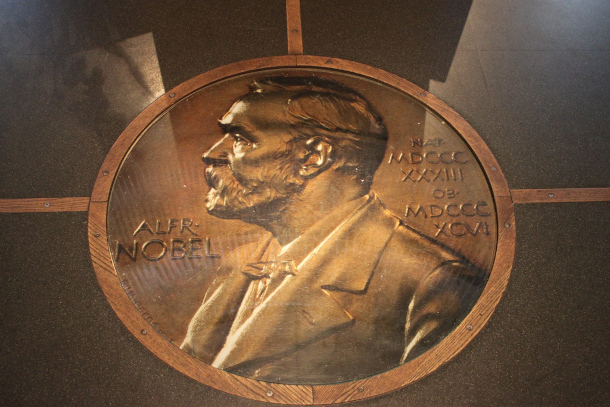
Alfred Nobel was granted patent number 78,317 on November 25, 1867 for dynamite. (Photo: Solis Invicti, Flickr, CC BY 2.0)
BASCOMB: I think a lot of our listeners probably would be surprised to hear that the Nobel Peace Prize has its roots in dynamite and, you know, weapons of war.
DYKSTRA: Yeah, that's about it. And of course, Nobel honors some great works of literature and science fields, ranging from economics to chemistry and physics all came into existence because of the success of dynamite.
BASCOMB: Alright, well, thanks, Peter. Peter Dykstra is an editor with Environmental Health News. That's ehn.org and dailyclimate.org. We'll talk to you again real soon.
DYKSTRA: All right, Bobby, thanks a lot. Talk to you soon.
BASCOMB: And there's more on these stories on the Living on Earth website. That's loe.org.
Related links:
- Learn more about the Gulf Oil Sale
- Learn more about Tangier Island and its rising sea levels
- Learn more about Alfred Nobel
[MUSIC: AC/DC, “T.N.T” on High Voltage, Australian Music Corporation Pty]
CURWOOD: Coming up – The Three Sisters Stew is a tasty option for Thanksgiving inspired by Native Americans, Keep listening to Living on Earth.
ANNOUNCER: Support for Living on Earth comes from Sailors for the Sea and Oceana. Helping boaters race clean, sail green and protect the seas they love. More information @sailorsforthesea.org. Support also comes from Friends of Smeagull the Seagull and Smeagull’s Guide to Wildlife. It’s all about the wildlife right next door to you!
That’s Smeagull, S - M - E - A - G - U - L - L, SmeagullGuide.org
[CUTAWAY MUSIC: Cyrus Chestnut, “Cooldaddy’s Perspective” on Earth Stories, Atlantic Records]
Little Progress at COP26
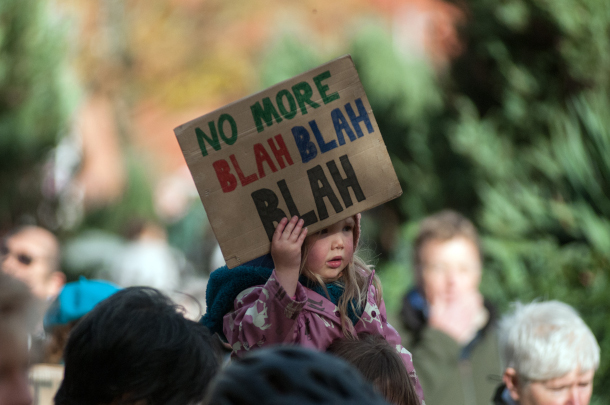
Youth climate activist Greta Thunberg denounced the climate talks by calling for “no more blah blah blah”. The image above was taken at a 4,000 people rally outside Sheffield’s City Hall at the time of COP 26. Protesters were demanding greater action from world leaders on reducing greenhouse gas emissions and addressing the climate catastrophe. (Photo: Tim Dennell, Flickr, CC BY-NC 2.0)
BASCOMB: It’s Living on Earth, I’m Bobby Bascomb
CURWOOD: And I’m Steve Curwood
The COP26 climate negotiations in Glasgow have come to an end leaving much unsolved in terms of how we will limit global warming to 1.5 degrees Celsius by the end of the century. These talks have been criticized for lack of inclusivity and for hosting more than 500 attendees with links to fossil fuel interests. The current pledges, or nationally determined contributions under the Paris Climate Agreement, would only limit global warming to about 2.4C, which could result in millions of deaths. So countries are now tasked to set even more ambitious targets by next year's round of climate talks in Egypt. Joining us for an overview of what was accomplished and what’s left to be done is Alden Meyer, a Senior Associate at the think tank E3G. Welcome back to Living on Earth Alden!
MYERS: Great to be with you again Steve.
CURWOOD: Let's talk about what just happened there. So at the last minute they yank the cord when it comes to phasing out coal, what needs to happen in the next round of negotiations to deal with coal?
MYERS: Well, actually, this was a real breakthrough. This is the first time in the history of the COPs where there's been a reference to the need to phase down any fossil fuels in the final decision. So we need to start there and you have to remember, at the G20 Leaders Summit, just before the cops started held in Rome, they weren't able to get agreement on saying something about phasing out or phasing down coal. So this was really some progress. And of course, we know that countries like China and India are not going to phase down coal entirely by 2030. So having this in there will be important and the key will be what will these countries come back with next year in Egypt in terms of what they're willing to do to start phasing down coal.
I am incredibly grateful to everyone who has helped get us here today in Glasgow
— Alok Sharma (@AlokSharma_RDG) November 13, 2021
But this is a fragile win
We have to continue to work together to kept 1.5 alive
Read my full statement here on the outcomes of #COP26: https://t.co/SHP22t3bDc pic.twitter.com/8xSCZA7I10
CURWOOD: What's the difference between phasing out and phasing down by the way?
MYERS: Well, phasing out implies getting to zero and phasing down means reversing the increase and starting to reduce. So phasing out is clearly stronger and that was the original proposal from the UK presidency. And we had this drama at the last minute that China and India raised objections to that, and forced revision of the language from phase out to phase down. We're told that China expected others to object to this and get it taken out of the final decision before they even had to have a floor fight and where caught a little unaware. India was the one that took the lead, proposing and reading out the revised language on the floor.
CURWOOD: Hey Alden, let's talk about loss and damage. The rich nations apparently didn't want a standalone deal on this, so what can be done about it? A lot of talk but so far, not so much action right?
MYERS: Well, first, let's clarify for people what loss and damage is. President Obama's science advisor John Holdren once famously said, we're going to deal with climate change through a mix of three strategies, mitigation, adaptation and suffering, and loss and damage is really the suffering. It's the impacts that countries are already experiencing, and communities around the world from typhoons and hurricanes to wildfires to floods, other extreme climate impacts, and those impacts are mounting year by year. Loss and damage is a provision of the Paris Agreement. It's added to adaptation and mitigation, and there's a responsibility to start to address it. But for the last eight years or so there's really been very little movement from the developed countries on their willingness to provide resources, finance and technology support and other things to these countries to deal with loss and damage. That really came to a head in Glasgow, that was a more high profile issue than it's ever been in this process. The developing countries were pushing for what they called a facility to be operating under the UN framework on climate change, which would start looking at ways to generate substantial resources to help them cope with these impacts. The US and others opposed, creating a new facility but they did agree to four dialogues over the next two years to start talking about this issue. That's clearly not what the developing countries wanted. But its progress and will provide a pretty high profile political platform to start having that discussion about how we actually mobilize substantial resources to help these countries.

Members of the Civil Society Action Network calling for action on loss and damage at the COP26 climate talks. (Photo: Kiara Worth, Flickr, Civil Society Action, CC BY-NC-SA 2.0)
CURWOOD: And when you use facility, really, you're talking about money, you're talking about funds?
MYERS: Talking about money. It would be a mechanism under the the Framework Convention to generate and handle funding coming through. But of course, the fear of the US, Europe and others, is that they will be held accountable for their historical emissions. The US, Europe, Japan, and others still have some of the highest cumulative emissions over the last century or so and there's this fear of being subjected to open ended liability or compensation for those emissions.
CURWOOD: Let's talk about more money issues. There's a whole question of climate finance, this promise that was made in Copenhagen that was supposed to begin in 2020. Whatever happened with that?
MYERS: Well, it's always been a perennial issue at these meetings. It was high profile at this one loss and damage finance was of course, part of that adaptation finance was on the agenda and the developed countries did agree that they would try to double the amount of finance support coming from them for adaptation activities in developing countries, between now and 2025. So that was a win for the developing countries. The other issue of course was the developed countries have not yet met their commitment that they made 12 years ago in Copenhagen to provide $100 billion a year in finance for mitigation and adaptation, that was discussed. There was agreement that they needed to do better at meeting that target and to make up for the shortfalls in the first few years of of this decade if they can before that commitment ends in 2025. The third issue, big issue on finances is what happens after 2025? There's general agreement that we need to ramp up the amount of finance going to developing countries and they launched a process to negotiating that issue over the next two or three years. One of the big fall lines there as the US and other developed countries want to expand the base of donors to include China, Saudi Arabia, other relatively wealthy developing countries and of course, that will be a huge battle.
CURWOOD: Now one of the things that looks like it got done in Glasgow also involves money, and this is the trading of emissions reduction credit. Talk to me about the rules of the road for this process and what exactly was agreed to in Glasgow?
"Unless COP26’s failure is recognized as failure, there is no way to learn from it. Allowing global leaders to feel that what happened in Glasgow was acceptable — and spinning it as some sort of success — would be a disastrous mistake." #COP26 https://t.co/6mNJfCXGyb
— Greta Thunberg (@GretaThunberg) November 17, 2021
MYERS: Well, this is an issue that was supposed to be resolved three years ago at the COP and Katowice, Poland. And of course, they couldn't reach agreement there. They couldn't reach agreement in 2019 in Madrid. And so this was kind of the third time up at bat for this issue. And the UK and others were able to get it across the finish line, they adopted rules for what's called the Article Six of the Paris Agreement use of market mechanisms. And you know, the carbon markets are existing, they're out there on a bilateral basis, a number of companies are using offsets to deal with their emissions but this is to set up a global regime and sort of rules for the road. They did reach agreement on it, it's not perfect, it still will allow some carryover of sort of bogus credits under the Kyoto regime into the Paris regime, which will water down the system a little bit. But it's a pretty good system. And of course, the countries like Europe and the US and others that are protecting environmental integrity now have to make sure that they don't buy any bogus credits or tons of emissions reductions from from countries. So it'll go forward, it's good to have it resolved and off the radar screen. I think there's an open question about how large this market will grow over time. There's also a question of what is the role for offsets overall, in a world where we're trying to get to net zero emissions, if everyone has to get to zero, you can't really have a lot of trading going on. So this is a work in progress and we'll see how the market develops over the next several years.
CURWOOD: How appropriate is the negotiation process that we're in right now with these conferences of the parties, these these cops? Because, you know, I don't know that nature and science care, that we're disputing things and not coming to agreement?
MYERS: No, they don't. The atmosphere responds to one thing which is emissions, it really doesn't care much about what leaders say what treaties we adopt, what protocols we put in place, it responds to physics. And we're not doing very well on that front, we're still on track for an increase of about 10 to 15%, above current levels by 2030, as opposed to the 45% reduction that we need. So that's the bad news.
CURWOOD: At the end of the process, as the President of the Conference of the Parties is a British member of parliament brought the gavel down, Alok Sharma, he also took time to apologize. Why did he feel that he had to apologize?
MYERS: He apologized because there was sort of an irregular issue that came up at the end where China and India were not willing to accept the final language on the phase out of coal and the phase down of fossil fuel subsidies. It was not a transparent process, these countries basically came to him and said they would block the entire agreement, all the package that we had spent two weeks negotiating or actually two years negotiating, If they didn't get their way on this. You saw a number of angry statements from countries after India made this proposal that, first of all, they didn't agree with a proposal, they said we need to phase out coal if we're going to have any chance of 1.5 C. They also didn't like the process. They said, look I've got issues I would like to raise and I would like to approve the agreement, I was not given that opportunity and this was not done in a very transparent way. And they were basically objecting to the threats that India and China were making to block the whole package if they didn't get their way in watering this coal language. And that's when you saw President Sharma apologize to the rest of the countries there for the process and how it had played out and he really got quite emotional and kind of teared up at the end of that it was quite a dramatic moment.

Alden Meyer is a Senior Associate at E3G working on US and international climate policy and politics. He is a Principal at Performance Partners, which provides a range of consulting services to clients in government, business, and the non-profit sector. (Photo: Courtesy of Alden Meyer)
CURWOOD: Should the world be crying too?
MYERS: I think you could say the world should be crying. I mean, there is a total disconnect between the rhetoric of many of these leaders that climate change is an existential crisis and their behavior, which in many cases is going about their business as if nothing was happening. I mean, I don't know on the one hand how you can say our future and our way of life and our children are at risk and then do so little to address it. Now, of course that varies that's the dynamic here. This is 196 countries, some of them are making truly transformational commitments. Denmark, for example, is committed to reduce its emissions by 70% by the year 2030 but other countries aren't stepping up to the plate. And I would say also that the US and other developed countries really haven't done as much as we should to provide the financial resources to help these countries decarbonize. There was an announcement made during the first week about an agreement reached with South Africa between Europe, the US, the UK, and others to provide somewhere around eight and a half billion dollars to help them shift away from coal. That's the kind of thing we need to see happen with other big countries like India, Indonesia and others. We're running out of time. Ten, fiffty, one-hundred years from now our future generations will be looking back at us and saying: why didn't you do more? Why didn't you really step up? You said it was an existential crisis, but you didn't behave like it. Why not? And I think they'll be perfectly justified in asking that question.
CURWOOD: Alden Meyer is a senior associate at the think tank E3G. Thank you so much Alden for taking the time with us once again.
MYERS: Thanks, Steve. I enjoyed it.
Related links:
- BBC |” What Was Agreed at the Glasgow Climate Conference”
- Global Witness | “Hundreds of Fossil Fuel Lobbyists Flooding COP26 Climate Talks”
- The Guardian | “‘A Death Sentence’: Indigenous Climate Activists Denounce COP26 Deal”
- Human Rights Watch “COP26 Is Over – What’s Next for Forests, Coal, and Fossil Fuel Finance?”
[MUSIC: Snarky Puppy, Chantae Cann, “Free Your Dreams” on Family Dinner – Vol. 1, GrounpUP Music]
Three Sisters Stew for a Plant-Based Feast

The Three Sisters is an agricultural strategy in which winter squash, corn, and climbing beans are planted in a mound to grow symbiotically. Together, this trio of staple crops used in many Native American tribes throughout history. (Photo: John S. Quarterman, Flickr, CC BY 2.0)
CURWOOD: Well, Thanksgiving is just around the corner and if you want a vegetarian option or would like something beyond all the turkey, mashed potatoes, and stuffing, then we’ve got you covered. Three Sisters Stew is a Native American dish inspired by the three sisters of corn, squash, and beans traditionally grown together in many native gardens. Joining us now is Chef Steven Looney of the Aaimpa café at the Chickasaw Cultural Center in Sulfur, Oklahoma. Chef Steven, welcome to Living on Earth!
LOONEY: Thanks for having me, Stephen. It's wonderful being here.
CURWOOD: So when I was a kid, I went to the farm and wilderness camps where they taught us to farm by mounding up the earth, and putting corn seeds in and then putting bean seeds and squash seeds and had them all grow together. And we were told this was a Native American traditional way to grow food. And they call it something like the Three Sisters. So how did these three crops come to be planted together, Chef Steven?
LOONEY: So traditionally, Three Sisters is a symbiotic planting system. So what would happen is as the corn grows, it provides a stalk for the beans to trellis up to and give them root so they can actually continue to grow. And then from there, the beans would provide nitrogen for the soil for the squash and for the corn. So each plant helped the other plant grow and provided a nutrient that the other plant would have as a deficiency in the soil. So they back each other up like a family would.
CURWOOD: So it's getting to be colder now. And I'm thinking it might be fun to maybe have you tell me about a stew I could make?
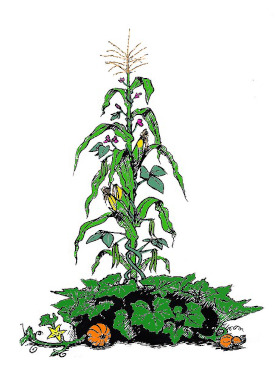
An artist’s representation of the Three Sisters planting strategy. (Photo: Garlan Miles, Wikimedia Commons, CC BY-SA 4.0)
LOONEY: Absolutely. So one of the most amazing things about the Three Sisters is the corn, we have something called the pashofa. A pashofa is a white pearl hominy, that's been dried. So with that, I like to take the pashofa, slow cook it for about 16 hours with pork, usually pork butt. And then usually within the last hour and a half of the cooking process, I'll add black beans and generally yellow squash, but I really like to add butternut squash to it because it holds up a lot better. So you have this really intense corn flavor, balanced with the the fattiness and the saltiness of the pork. And then you have the sweetness of the butternut squash in there. And then you get these nice little hits of earthiness from the beans and it's a very complex and depth of a dish for you know something that's just you know, corn, beans and squash.
CURWOOD: Okay, Chef Steven, what about a simple vegan stew with the three sisters?
LOONEY: Oh, absolutely, absolutely. You could take all those exact same things. And just instead of using pork, you could add spinach to it, you could add kale to it. If you were apt enough, you could add wild greens such as poke to there, or ramps to it. Those are all things that can be foraged in Oklahoma or in the in the homelands that the tribe absolutely would have used and would've ate and consumed.
CURWOOD: So Chef Steven, let me ask you what's a simple recipe starting with corn kernels, say something vegetarian?
LOONEY: So you can have a corn potash, which is a type of corn soup. And you could just take fresh corn or canned corn if you like. If it's canned, you should strain it and remove all the excess water. And you can just simply sautee that up in a stock pot with some onions and garlic. Add some vegetable base to it or some plain water and then just reduce the heat. And then after it starts to simmer, you could add onions and carrots, you could add peppers and onions, potatoes. And then once that cooks for a couple hours on low, remove about half of it and then puree that and so it becomes its own cream. So this way you don't even have to add cream to the soup. The vegetables itself has become its own sauce basically.
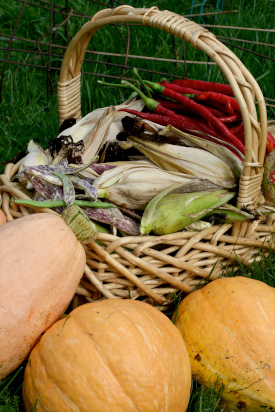
The Three Sisters planting strategy has been adopted by many home gardeners, who will often incorporate their other harvested produce into recipes that use the three sisters as a base. (Photo: Marguerite, Flickr, CC BY-NC 2.0)
CURWOOD: Mmm, so good. Of course, originally, these three foods were cultivated together. But nowadays, most people would find them in the produce section of a grocery store. What advice would you have for anyone who would like to adapt traditional recipes for today's kitchen?
LOONEY: You know, it's funny, growing up, you know, I wasn't really connected to my Chickasaw heritage as much as I am now. So to me, it's immensely surprising on how many foods are actually native foods. So, you know, all of our history is oral. So it's not like with French history, I can go get a cookbook from the 1500s and I can know what King Louis XV had, or what Marie Antoinette ate. You know, unfortunately my people, we share things orally. So a lot of it is just purely imagination based. Now, if you're really wanting to truly try foods that the tribe would have had, you know, you may not use obviously processed foods, you know, don't use, you know, all sorts of extracted oils like olive oil, palm seed oil, stuff like that. You can use lard, you know, if you have access to that, you can use that. But a lot of the foods would be considered what someone will say is humble, right? They didn't have necessarily special knives or special cooking equipment, you know, they smoked things, they boiled things, they dried things, they cured things like that. So a lot of what they ate is what some what some would say rustic you know, some would say humble. Someone say simple, but that's the type of food that my people ate.
CURWOOD: Steven Looney is chef at the Aaimpa Cafe at the Chickasaw Cultural Center there in Sulphur, Oklahoma. Steven, thanks so much for joining us today. I'm gonna try some of these in my own kitchen.
LOONEY: Well, I appreciate your time, Stephen. It's been a pleasure to be able to speak with you today.
NOTE: Chef Steven's remarks reflected his personal views. He did not speak on behalf of the Chickasaw Cultural Center or the Chickasaw Nation.
Related link:
Read More on the Three Sisters from the First Nations Technological Institute
[MUSIC: Tomas Walker, Ashtar Ron Allen, “The Redeemer” on World Flutes, Reflections]
BASCOMB: Coming up – A new novel, the Seed Keepers, looks at the sacred relationship between humans and the seeds that sustain us. That’s just ahead on Living on Earth.
ANNOUNCER: Funding for Living on Earth comes from you, our listeners, and United Technologies, combining passion for science with engineering to create solutions designed for sustainability in aerospace, building industries, and food refrigeration.
[CUTAWAY MUSIC: Tomas Walker, Ashtar Ron Allen, “The Redeemer” on World Flutes, Reflections]
The Seed Keeper
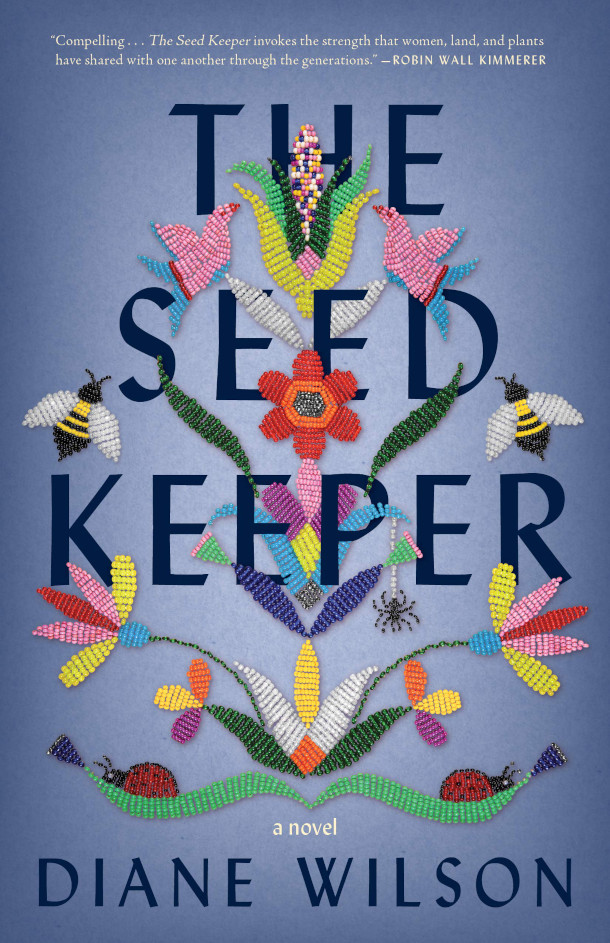
The Seed Keeper is the newest novel from author Diane Wilson. (Photo: Courtesy of Diane Wilson)
CURWOOD: It’s Living on Earth, I’m Steve Curwood.
BASCOMB: And I’m Bobby Bascomb
This harvest season is a time when many of us turn to native American foods to give thanks. Afterall, for many, what is Thanksgiving without potatoes, green beans and pumpkin pie? The seeds for so many of our favorite foods of the season have been passed down through generations of Native American women. That tradition of keeping seeds is the backdrop for Diane Wilson’s novel, The Seed Keeper. A work of historical fiction, Diane tells the tale of 4 generations of Dakota women who, despite the hardships of forced displacement, residential schools, and war still managed to save the life giving seeds of their people and pass them on to their daughters. When Diane Wilson is not winning awards as a novelist, she is also the Executive Director for the Native American Food Sovereignty Alliance. And she joins me now. Welcome to Living on Earth Diane!
WILSON: Glad to be here.
BASCOMB: So Diane, what inspired you to write this book?
WILSON; Oh, well that's one of my favorite questions. You know, getting to relive the moment where these ideas come to you, even though I think it really grew over a few years. But there was a moment in about 2002 when I was participating in an event called The Dakota Commemorative March, and that was a biannual event to just honor and remember the 1,700, Dakota men, women, children and elders who were removed from the state after the 1862 Dakota War. So on this long walk, which was about 150 miles, somebody told me a story about the women who were preparing to be removed from the state and how they didn't know where they were going to be sent. They didn't know how they were going to feed their families, they didn't know what they were going to be able to grow. And so what they did was sow the seeds that they had gathered each summer in the hands of their skirts and they hid them in the pockets. And so that way, no matter what happened, they would have these seeds wherever they ended up. It was actually that story that stuck with me, that act of just fierce courage and protection for seeds. And it was it was a reminder to me of our responsibility to take care of these seeds and that when we do when we show that kind of commitment to them that they also take care of us. So it was that story combined with working at nonprofits doing similar work around seeds, protecting them and growing them out for communities that they came together in a novel.
BASCOMB: Now, the protagonist of your story is Rosalie Iron Wing, and she loses her father when she's young and basically grows up in the foster care system. But she eventually marries a white farmer. And there's a scene in your story where their farmhouse catches fire. And Rosalie's his first instinct is to save a box of seeds that she inherited from her mother in law. And her husband is kind of angry at her that she didn't first look for their son. But Rosalie has a friend named Gabby, who's another Native American woman, and she has a really different perspective on Rosalie's instincts there. Can you tell us how she responded?
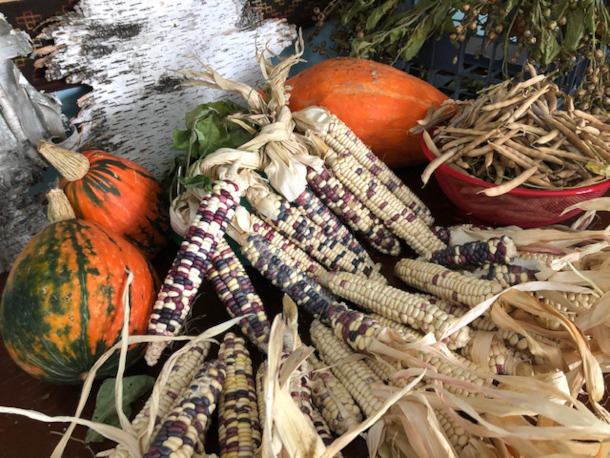
Diane Wilson’s 2020 harvest of native corn, beans, and squash. (Photo: Courtesy of Diane Wilson)
WILSON: So Gabby brought forward that perspective that comes out of a need to survive, and how in difficult times, women have had to make decisions that in immediate were very painful but that allowed their community or their family or their people to survive. And so I felt like that was a perspective that needed to be brought forward, just as the women that I mentioned in the 1862, Dakota March knew that their survival might depend on those seeds. And that I think one of the issues that we face today is the fact that we've forgotten that connection, that our survival literally depends on not only our relationship with seeds, but with water, with all of the other plants around us with animals with all of these gifts that we receive that give us the gift of life.
BASCOMB: Eventually, Rosalie's family along with many other farming families in the area, they're struggling financially, and a company that you call Mangenta comes to town and offers farmers genetically modified seeds, which they promise will yield more corn. The GMO seeds promise more money but there is resistance from some people in town. How did the introduction of GMO seeds affect the community and eventually Rosalie?
WILSON: Well, I really wanted to portray the challenges that farmers are also facing trying to make a living as farmers and to show that evolution of the way that farming has developed, especially since World War II, when big chemical companies got involved and not only found ways to introduce chemicals that were leftover from World War II, but also to make a partnership between the use of chemicals and seeds and start to control the seed inventory in the country. And I think this is really critical history for us to understand that the way farming and gardening began, it was much more of a sustainable practice where people were trying to grow enough to provide food for their communities but as it evolved and became more of a corporate practice, then what we see is decisions that are being made because of a profit, because of a bottom line perspective. And that introduced this idea that our foods, our seeds, our plants our animals our water are all commodities and they can be sold. And if you can look at something as a product as opposed to a relative or a being, then it makes it much easier to rationalize how you're treating those seeds and those plants and those animals.
BASCOMB: Diane if native seeds could talk, what do you think they would say about how we've changed our relationship with land and farming?
WILSON: You know, that was actually one of the questions I asked myself during the writing process. And because I was writing in the first person, it was really important to me to be able to understand each character's viewpoint. And so what the seeds had to say was that there was an original agreement between the seeds and human beings. And in that agreement the seeds gave up their wildness, and in return, agreed to take care of human beings. And the human beings agreed as well to care for the seeds. When you carry that kind of reciprocal relationship, then you end up taking care of each other. And what's happened though, and this is where the story of the way farming has evolved become so important, what's happened is that human beings have forgotten to uphold their side of the relationship and instead have have really taken advantage of seeds in turning them into this genetically modified organism. Is that a way that you would treat a relative? Is that what is best for the seeds themselves? So if you considered the health of the seeds, the rights of seeds as a living organism, then human beings have broken that agreement. And what happens when you break an agreement with another being is that they may just leave. And that's what we've been seeing so much of with you know such a vast proportion of our seeds having already disappeared from the planet that, that lack of care that lack of upholding that relationship means that we're losing one of the most critical sources of diversity on the planet.
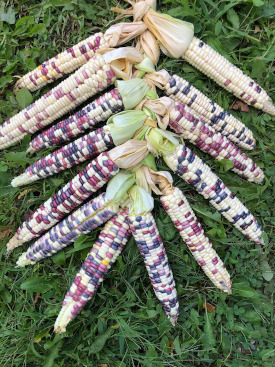
Native corn is one of the oldest varieties of corn and it’s the corn that Native Americans taught European settlers how to cultivate. (Photo: Courtesy of Diane Wilson)
BASCOMB: Diane, you're the executive director of the Native American Food Sovereignty Alliance and a lot of your work, as I understand it focuses on building sovereign food systems for Native peoples. And of course though, at the same time, you know, there was a time in the pandemic, when the US Food System really faltered. After that interest in gardening shot way up, but I think a lot of us are still hesitant to try and save our own seeds, you know not quite sure how to go about doing it. And I have to say, I grow a pretty big garden each year and I, you know, the sunflowers drop down and make sunflowers the next year and that's great but I don't really do a lot of seed saving. Can you give us some practical examples of how gardeners can save their seeds? And why do you think it's important to do that?
WILSON: Well, you can grow beans, dry beans are probably the easiest plant to start with in terms of saving your seeds. And there's many beautiful varieties. But if you grow beans to be dried down, then the same bean that you're saving to use in your soup is the bean that you're going to save and use in your garden. And they don't cross pollinate, so you don't have to worry about doing anything to protect them from other species. So beans are fantastic. I think that's probably the easiest one to start with. I think that even if you're not going to save your seeds, it's fun and it's really educational, to even save one. So that you're having that experience or you're having that relationship, you're understanding what is the process of saving seeds and you're going all the way through the cycle with the plant. But the gift of even just saving one of your seeds. One variety is that it teaches you a mindfulness, it teaches you to be present in a way that I think the world around us often pulls us away. You know we're on Zoom a lot and there's all kinds of social media distractions, we're working, we have all these things to do but a seed needs to be tended in its own time. So you pay attention to those seeds in order to have them for the next season.
BASCOMB: And in doing so you're upholding our part of the bargain, as you talked about earlier.
WILSON: Yes. And I think that we have gotten so far away from general practice of seed keeping. But at the same time, there are places that do and a lot of people that do. So, there are seed libraries now, there are you know, Seed Savers in Iowa does a beautiful job of tending seeds so that you have access to good healthy seeds that have been grown organically. So even if you're not saving your seeds to grow out each year, at least be supporting the people and organizations who are caring for seeds.
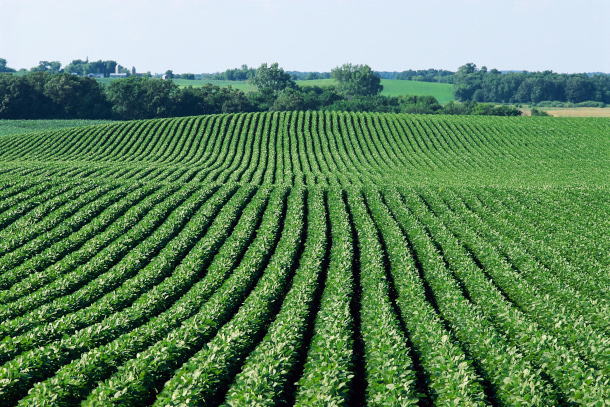
Minnesota is one of the top United States exporting states for soybeans, corn, livestock products and wheat, most of which are grown via monocropping and genetically modified seeds. (Photo: MPCA, Flickr, CC BY-NC 2.0)
BASCOMB: And you know, I would think with a changing climate, it's probably more important than ever to have a diversity of seeds. You know, some might be more well adapted to drought conditions that we're going to be seeing in the future, or cold or hotter, or whatever it might be. I mean it's a nice thing to do but it's also a pretty practical thing to do at this point and when we're looking at our own food security.
WILSON: Yeah, I would say it's fairly critical that we be growing the seeds out every year. And I understand the need for a place like Svalbard so that, you know, in case a country does face a catastrophic natural disaster then you know, what happens if your seed inventory gets wiped out, for example then you've got a place like Svalbard that hopefully has that seed banked inventory to replenish your crops. But longer term a place like Svalbard doesn't have the capacity to be able to grow those seeds out. And seeds are living beings so if you're not growing them out, frequently, then they are going to lose viability with each passing year. And even though it's in a deep freeze, that's still losing viability. So at some point, they have to be grown out and if they're not being grown out, they're not adapting. So to me, one of the safest ways to protect your seeds would be if I'm growing out let's say Dakota corn in my garden and then you're growing this corn in your garden and somebody else in another third area is growing it out and if I get hit by hail, then maybe your garden makes it and we can share those seeds back again. Which also, by sharing seeds grown in different regions they're continuing to maintain a very robust viability and adapting to different conditions. And then, of course you know, we all grow out our gardens and in the fall this time of year what's the best thing to do but to get together with your family and your community and share your harvest. So when you're doing seed work, you're building community, you're protecting the seeds and you're also taking care of not only your own health but also the health of the soil.
BASCOMB: And Svalbard for our listeners who maybe aren't familiar with it is a deep underground seed repository, a seed bank.
WILSON: Yeah, it's in Scandinavia, and it was built into a glacier but the glacier is also melting. So I see the utility of it but is that really going to be feasible long term?
BASCOMB: Well Diane, I have to say, I really enjoyed your book I honestly did. It's compelling and it's beautifully written. In the end, what do you hope that readers will take away from this story?
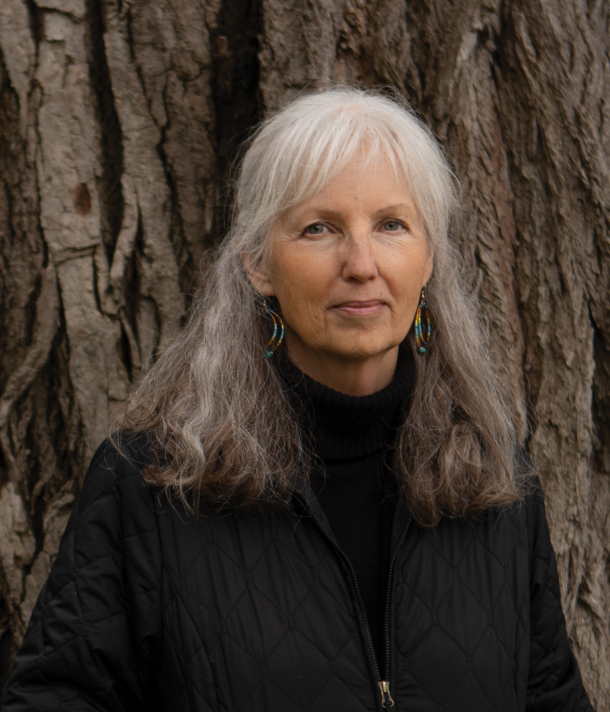
Diane Wilson is a Dakota writer, speaker, and editor, who has published two award-winning books including her most recent novel The Seed Keeper. She is also the Executive Director of the Native American Food Sovereignty Alliance. (Photo: Sarah Whiting)
WILSON: I think more than anything, I would love it if readers would just reflect on what their relationship is to the world around them to the natural world. So that we don't take for granted, the seeds that we grow, we don't take for granted the water that we're provided with and in all the ways in which our food system has been made so easy for us. But at the same time, the sacrifices that have been part of giving up our participation in what is our own creating and growing our own food has meant that the world has really changed a lot and in terms of our relationships to everything around us. And I feel like as human beings, we are really suffering the consequences of that, not only in terms of what's happening in climate change but just in terms of who we are as human beings and what it means when we're raising children who are afraid of bees, who don't know that their food is grown in a garden, who don't know how to steward then the earth that they're going to be in charge of in a few years. So I hope the reader takes that and that sense of responsibility. And that's why I tried to tell the story across multiple generations so that you see it rolling forward that each generation is responsible for doing this work and making sure that the next generation understands their responsibility, and that gets passed on along with the skills to take care of it.
BASCOMB: Diane Wilson is author of the gripping novel The Seed Keeper and executive director of the Native American Food Sovereignty Alliance.
Related links:
- Learn more about Diane Wilson
- Learn more about the Dakota Commemorative Walk
- Civil Eats | “Gardening is Important, but Seed Saving is Crucial”
- Learn more about NAFSA, The Native American Food Sovereignty Alliance
- Food Diversity and Indigenous Food Systems to Combat Diet-Linked Chronic Diseases
[MUSIC: Tomas Walker, Ashtar Ron Allen, “Emerald Mist” on World Flutes, Reflections]
CURWOOD: Living on Earth is produced by the World Media Foundation. Our crew includes Naomi Arenberg, Paloma Beltran, Jenni Doering, Mark Seth Lender, Don Lyman, Aynsley O’Neill, Jake Rego, Genevieve Santilli, Teresa Shi, Gabriell Urton, and Jolanda Omari.
BASCOMB: Tom Tiger engineered our show. Alison Lirish Dean composed our themes. You can hear us anytime at L-O-E dot org, Apple Podcasts and Google Podcasts, and like us, please, on our Facebook page - Living on Earth. We tweet from @livingonearth. And find us on Instagram at livingonearthradio. I’m Bobby Bascomb.
CURWOOD: And I’m Steve Curwood. Thanks for listening!
ANNOUNCER: Funding for Living on Earth comes from you, our listeners, and from the University of Massachusetts, Boston, in association with its School for the Environment, developing the next generation of environmental leaders. And from the Grantham Foundation for the protection of the environment, supporting strategic communications and collaboration in solving the world’s most pressing environmental problems.
ANNOUNCER 2: PRX.
Living on Earth wants to hear from you!
Living on Earth
62 Calef Highway, Suite 212
Lee, NH 03861
Telephone: 617-287-4121
E-mail: comments@loe.org
Newsletter [Click here]
Donate to Living on Earth!
Living on Earth is an independent media program and relies entirely on contributions from listeners and institutions supporting public service. Please donate now to preserve an independent environmental voice.
NewsletterLiving on Earth offers a weekly delivery of the show's rundown to your mailbox. Sign up for our newsletter today!
 Sailors For The Sea: Be the change you want to sea.
Sailors For The Sea: Be the change you want to sea.
 The Grantham Foundation for the Protection of the Environment: Committed to protecting and improving the health of the global environment.
The Grantham Foundation for the Protection of the Environment: Committed to protecting and improving the health of the global environment.
 Contribute to Living on Earth and receive, as our gift to you, an archival print of one of Mark Seth Lender's extraordinary wildlife photographs. Follow the link to see Mark's current collection of photographs.
Contribute to Living on Earth and receive, as our gift to you, an archival print of one of Mark Seth Lender's extraordinary wildlife photographs. Follow the link to see Mark's current collection of photographs.
 Buy a signed copy of Mark Seth Lender's book Smeagull the Seagull & support Living on Earth
Buy a signed copy of Mark Seth Lender's book Smeagull the Seagull & support Living on Earth

